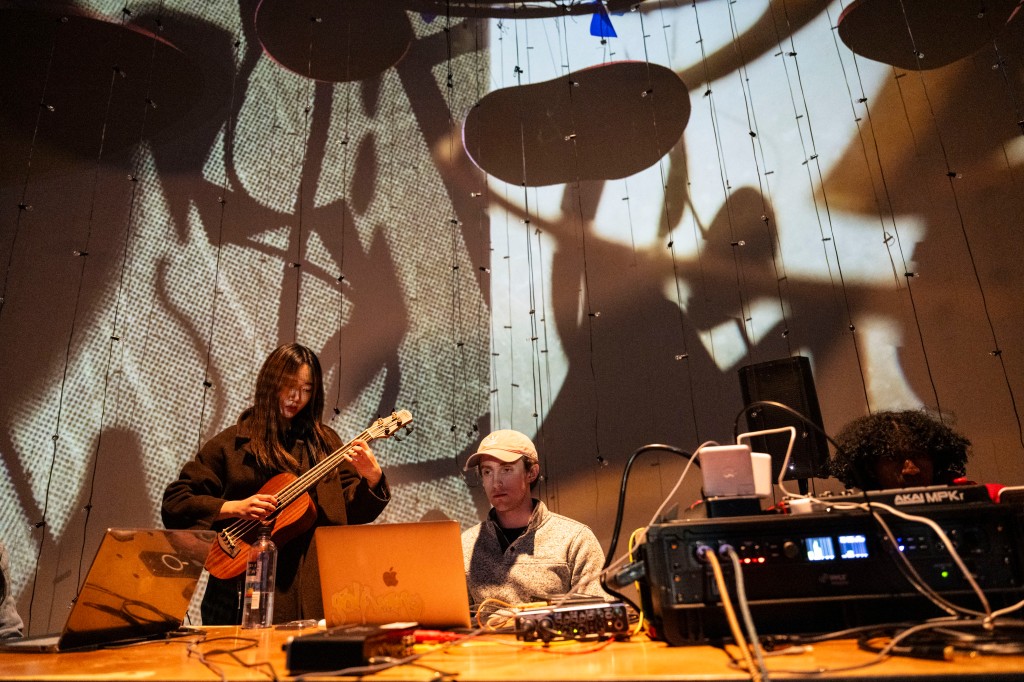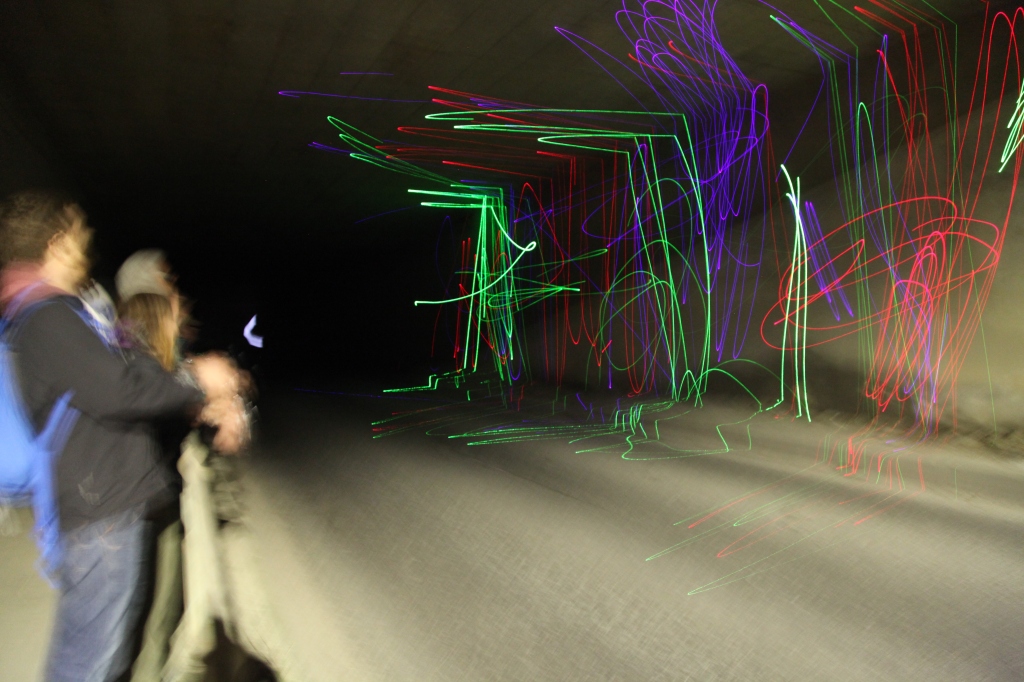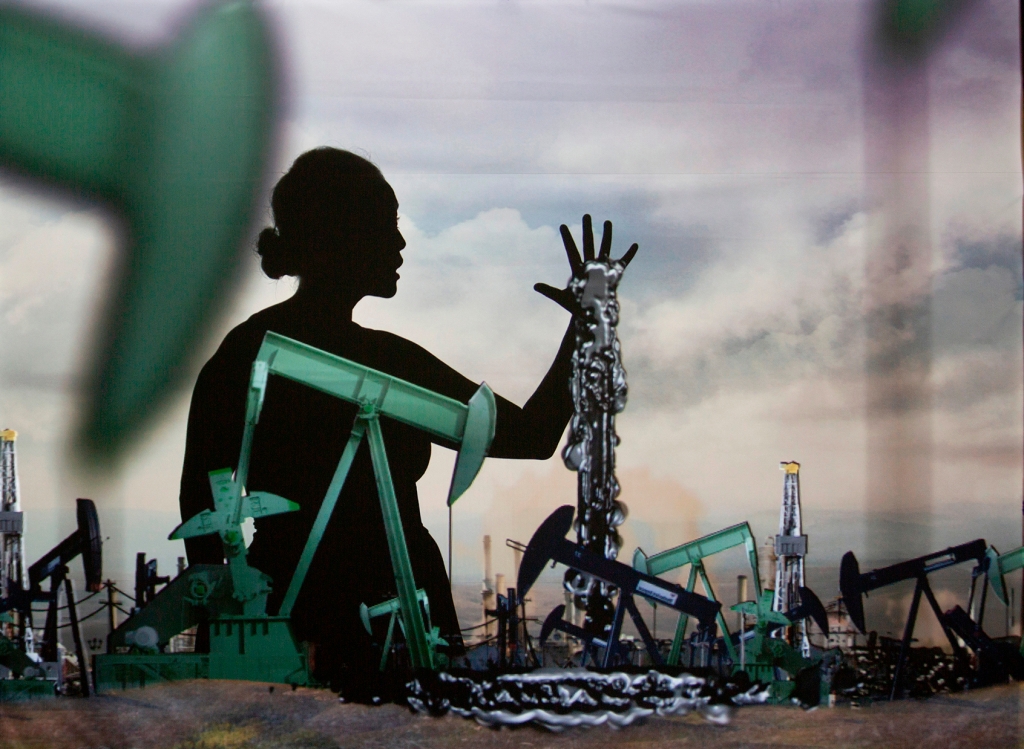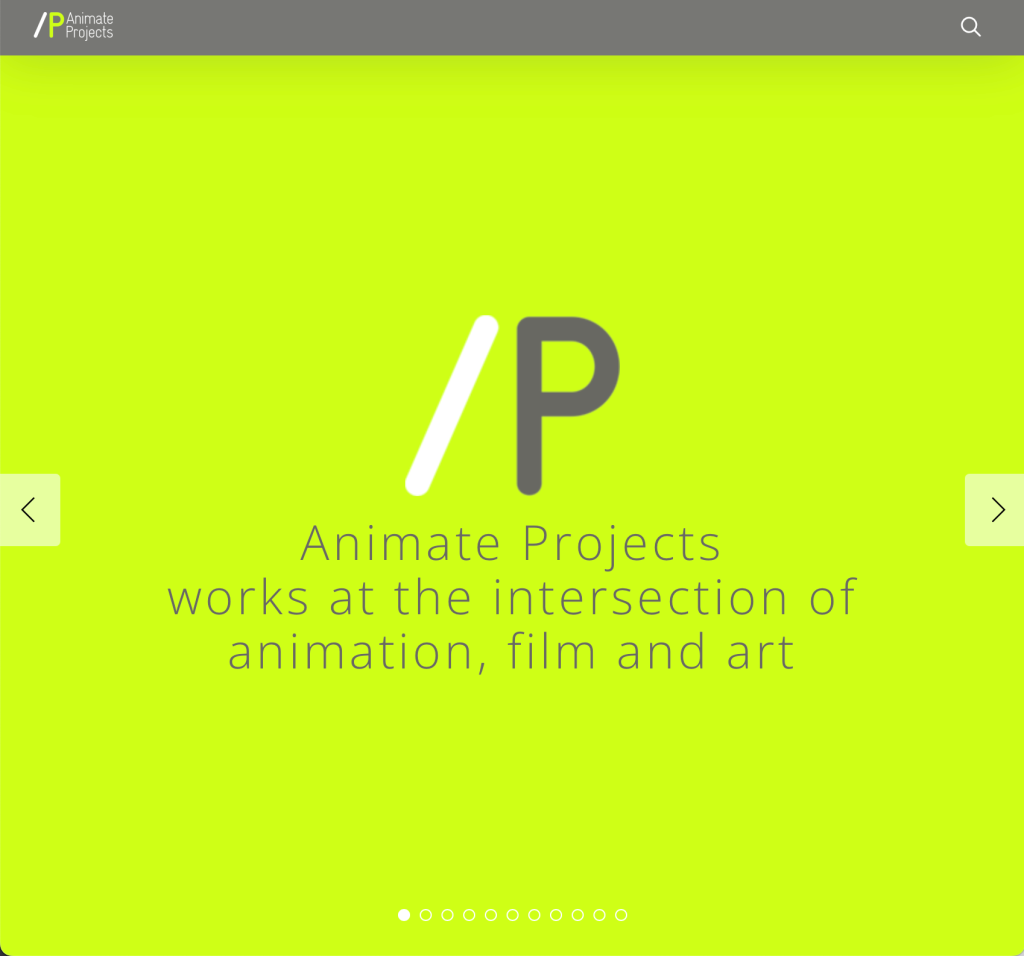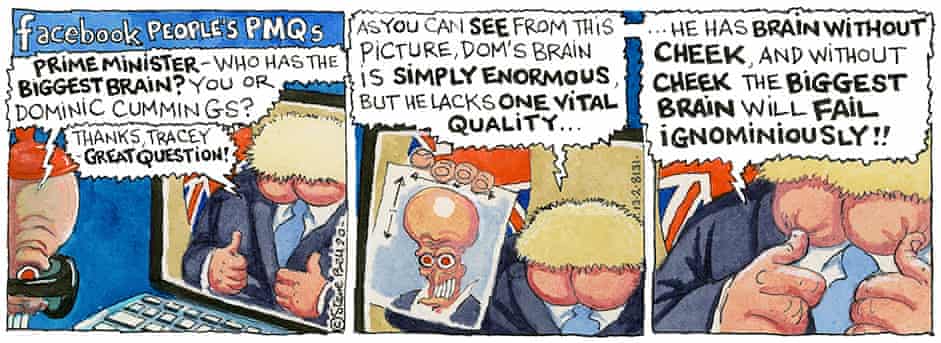
[Keynote speaker Steve Bell ©Steve Bell/The Guardian, 13/2/2020]
Delighted to announce that we will be live streaming this event at:
https://estream.ucreative.ac.uk/View.aspx?e=G15_RG21
Please note that the link will not be live until Monday morning.
Schedule for the day:
9.30-10.00 Registration/Coffee
10.00-10.05 Opening Remarks Tom Lowe / Dr Birgitta Hosea
10.05-10.50 Keynote 1 Dr Sharon Lockyer (Brunel University London)
10.50-12.00 Panel 1: Performing satire
Dr Maggie Gray( Kingston School of Art), Pierre Floquet (Bordeaux INP, France), Kate Jessop (University of Brighton)
12.00-12.20 Coffee Break
12.20-13.30 Panel 2: Absurdity and the destabilisation of authority
Prof. Fran Lloyd (Kingston School of Art), Sarah Tehan (Belfast School of Art, Ulster University) David Wischer (University of Kentucky, USA)
13.30-14.30 Lunch Break
14.30-15.30 Keynote 2 Steve Bell
15.30-16.00 Coffee Break
16.00-17.10 Panel 3: Politics and propaganda from print to the pixel
Dr. Driss Faddouli (Chouaib Doukkali University, El Jadida, Morocco) Prof. Paul Ward (Arts University Bournemouth) Dr. José L. Valhondo-Creg (Universidad de Extremadura, Spain)
17.10-17.40 Closing discussion with all panellists
17.40-18.00 Curator introduction to exhibition Jim Walker (UCA)
18.00-20.00 Bob Godfrey: A Collaborative Act Exhibition opens with drinks in James Hockey Gallery
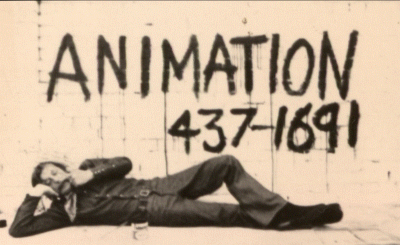
Presenter Details and Abstracts

Keynote 1: Dr Sharon Lockyer
Sharon Lockyer is a Reader in Sociology and Communications and the founding director of the Centre for Comedy Studies Research (CCSR) at Brunel University London, UK. Her research interests include critical comedy studies, identity politics and comic media representations and the sociology of popular culture, and she is widely published in these areas in books, journal articles and blogs. Recent work in these areas has been published in Feminist Media Studies, International Journal of Communication, Disability & Society and The Journal of Popular Television. She is the founding co-editor of the Palgrave Studies in Comedy book series and was executive board member-at-large for the International Society for Humor Studies (ISHS) from 2016-2019.
Dr Maggie Gray, ‘Cartooning and Performance: ‘Cartoon Style’ Alternative Theatre’
Experimental alternative theatre groups of the 1970s and 80s developed a form of performance that came to be known as ‘cartoon theatre’. This meant not only drawing on cartoon characters, conventions and imagery, but developing a distinctive ‘cartoon style’ mode of presentation – a stripped-down, fast-paced, surreal and stylised approach to narrative, abbreviated characterisation, and emphasis on breaks and movement between action. As an approach this was seen to match wider political aims to create rebellious, dynamic, anti-naturalist forms of theatre that could radically deconstruct and transform the world. In connection with the way alternative theatre drew on traditions of popular performance like music hall, cartooning was also seen as a carnivalesque visual mode appropriate to the non-traditional performance spaces like the street, pub, club, trade union hall, arts lab, picket line and community centre in which these groups performed, and attuned to the working class, countercultural and marginalised audiences they wanted to engage.
This paper will explore how and why these theatre collectives appropriated cartooning for the purposes of artistic and political subversion and what this suggests about the politics and aesthetics of cartooning. Drawing on archival research, it focuses on the work of C.A.S.T. (Cartoon Archetypical Slogan Theatre), a working-class socialist theatre ‘gang’ who pioneered this kind of performance. C.A.S.T. produced a series of short, improvised plays centred on iterations of an ‘Arch-typical’ Muggins character, and developed an anarchic, condensed, quick-fire and highly physical style of production. Described as ‘presentationalism’, this was designed to grab the attention of audiences in the way pop cultural forms like rock’n’roll, and comic books did, and to hold a subversive satirical mirror to social reality that attested to the possibilities of its radical alteration.
Bio: Maggie Gray lectures in Critical and Historical Studies at Kingston University, UK. Her research has focused on the history of British comics, in particular, the work of Alan Moore. Her book, Alan Moore, Out from the Underground: Cartooning, Performance and Dissent, which looked at Moore’s early work as a cartoonist in relation to his wider practice as a musician, poet, playwright and illustrator, was published by Palgrave in 2017. She is particularly interested in the performative aspects of comics, and the politics of performance thereby invoked. She is currently researching the intersections of the alternative theatre and alternative comics movements in the UK (1968-1990).
Pierre Floquet ‘Tex Avery as the Noah Webster of Cartoons’
A selection of iconic and more remote characters, of various cultural and moral issues are looked upon as as many telling examples of what Avery brought forward and played with over his twenty years or so of creation, as he developed his own style both in storytelling and aesthetics.
This analysis is both centripetal and centrifugal. What inspired him? The chronology of his cartoons both claims a very strong bound with US culture at large, and reflects the evolution of the latter. Meanwhile, as in a give-and-take momentum, Avery would interact with contemporary animators (Disney, the Fleischers, UPA artists), and with fellow artists from Hollywood studios. As a result Avery would participate in an informal creative pool, beyond and within his own team of animators, he would inspire with his own vision of the craft (C Jones, B Clampett, UPA, among others).
Consequently, Avery triggered out some original artistic standards in animation, which still prevail today. This was made possible as his films can hardly ever be considered as “one-offs”; beyond themes and characters, they follow a fairly strict set of recurrent codes of narration and representation. Avery simultaneously suggests cultural and moral subversion, and yet celebrates and abides by mainstream Hollywood / US social expectations (the issue of satire is to be discussed). As it is, one may speak of a cinematic comic language. Actually, in the long run, spectators are able to watch and spot / read and decrypt a given situation with its corresponding sound-effects, its iconographic denotation, its narrative offset. From there on Avery establishes a privileged pragmatic relation with them, and then plays with their expectations, either satisfying or – comically – frustrating them before he may carry them away into one further gag.
Bio: Pierre Floquet teaches English, and is associate professor at Bordeaux INP. He wrote on linguistics applied to animation film, organized Avery retrospectives and conferences, and was a juror at animation festivals in France and abroad. He has extended his focus to live action, participating in French and international books and journals. He edited CinémAnimationS (2007), and published Le Langage comique de Tex Avery (2009). His recent works and articles deal with film aesthetics, movement in animation film, the interactions between content and form in animation film.
Kate Jessop ‘The politics of comedy – how has adult animation used satire as a vehicle for feminist cultural commentary?’
The recent #TimesUp and #MeToo movements have brought notions of inequality and sexual harassment to the forefront of cultural discussion. Because animation is such an engaging and accessible medium it can render itself to be a valuable tool for addressing both challenging and abstract topics, often through the genre of documentary but also through satirical comedy. Contemporary adult animation series’ such as Tuca and Bertie and Bojack Horseman have been at the forefront of examining both the female perspective and societies treatment of women through use of satirical humour.
I will examine how adult animation has documented and presented these often complex female experiences. How successful or authentic can animation be in highlighting what has traditionally been feminist issues. And how is that a political act within itself?
Bio: Kate Jessop is a multi award-winning animation filmmaker whose work spans across narrative shorts, artists’ film and comedy. She represented the UK in the Best of Women in Film and TV, was a Virgin Media Shorts Finalist and a Berlinale Talents 2019 participant both as director & with her comedy series Tales From Pussy Willow in the Project Lab. She has exhibited extensively internationally, undertaking artist residencies in Berlin, Istanbul and Reykjavik. She is a Senior Lecturer in Animation & has taught in China. Her paper on Animation as Activism has been presented at Goldsmiths College & Queering Animation the first ever conference on Queer Animation.
Prof. Fran Lloyd ‘Humour and the Subversion of Authority: The Animated Internment Drawings of Peter Sachs’
In interview for BBC 4’s ‘Animation Nation’ broadcast in April 2005, Bob Godfrey refers to the ‘enthusiasms’ of the Weimar-trained Berlin animator Peter Sachs (1912-1990) who led the Larkins Studio in London where Godfrey trained in the early 1950s alongside Keith Learner before setting up Biographic Cartoons Ltd. in 1955.
The son of a Jewish architect father and Lutheran mother, Sachs had worked with Berlin’s most highly-regarded experimental film animators: the Hungarian-born George Pal (born György Pál Marczincsak, 1908–1980) and the German artist and filmmaker Oskar W. Fischinger (1900–1967) in the early 1930s, experimenting with hand drawn cartoon animation and innovative stop-motion techniques. With the rise of Hitler, Sachs first fled to Eindhoven in Holland in 1934 where he worked on the famous animated advertisements produced by Pal’s studio for Philips Radio and Horlicks. After the invasion of Holland in May 1939, at the height of the refugee crisis, Sachs eventually secured a permit to enter Britain in June 1939 to work as a domestic servant, aged 27.
This paper focuses on Sachs’ hitherto overlooked contributions to the ‘The Onchan Pioneer’ camp magazine during his internment as a German speaking ‘enemy alien’ on the Isle of Man from 1940 to 1941. Within the restrictive space of internment, with limited material resources, Sachs produced a series of wordless vignette drawings for the weekly magazine where he used his skills as an animator and graphic designer to induce laughter among fellow internees and to subvert the camp’s authority. The black and white drawing panels, based on the everyday activities of the internment camp – the laundry, growing crops and raising farm animals – employ an economy of line that capture the sonic aspects of the camp and simultaneously humorously undermine such commands as ‘Get Ready for the Inspection’. Unable to produce film animations in the camp, Sachs’ drawings directly reference animation devices while pointing to the absurdities of camp life and were to have a profound influence on fellow German internee Kurt Weiler who later trained with Sachs before returning to the GDR in 1956.
Bio: Fran Lloyd is Professor of Art History and Co-Director of Kingston University’s Visual and Material Culture Research Centre. She has published widely on émigré artists/collectors in Britain, including the Latvian-born sculptor Dora Gordine and the American collector Stanley Picker. Recent essays on German-speaking refugee artists and their networks include: “Making Animation Matter: Peter Sachs Comes to Britain’ (2019); “Becoming Artists: Ernst Eisenmayer, Kurt Weiler and Refugee Support Networks in wartime Oxford” (2015) and “Kurt Schwitters: Responses to Place” (2013). She has also curated exhibitions on Kurt Schwitters at The Sayle Gallery on the Isle of Man to mark the 65th anniversary of his death and to commemorate his internment on the island (2013) and Art beyond exile: the first retrospective in the UK of Viennese-born artist Ernst Eisenmayer (2012).
Sarah Tehan ‘Captain Phineas May – War Cartoons 1940-1946’ ‘Prints in Motion’
The Cartoon within the Second World War was a vital element in the fight for the hearts and minds of the people. It was also used by combatants to send stories home of life at the front. Phineas May, like many, spent his war years’ miles away from family in a new and distant land. The main means of communication to home was the airgraph letter. For Phineas this was an opportunity to amuse his wife Vivienne with Cartoons, depicting life in the Garrison. The Cartoons presented an often satirical examination of life within the army. Serving in the Pioneers Corps in Egypt with African Garrison Companies, several of Phineas’ cartoons depict British African Soldiers during a time of change within the Empire. The Cartoons depict cultural differences between the British Officers and their African Soldiers, as well as the Arab Locals.
This presentation, will discuss the works of Phineas May and the representation of the African Soldiers serving in the British Army. May’s work used racial stereotypes and language to promote humour. Elements of the work seen through the contemporary lens would be considered offensive. Could the work still be seen as a moment of discovery, of different cultures for combatants during that period; whose experience of other cultures would be little to non existent? May’s work taken as a whole, shows both affection for the African Soldiers and amusement in their lack of understanding of British ways. The work presents questions of British humour in the face of war, representation of the colonised and stereotyping within Cartoons.
Bio: Sarah Tehan is a visual artist and researcher based in Belfast. Tehan is a PhD Researcher at Belfast School of Art, Ulster University and an Associate Lecturer at the University for the Creative Arts, Farnham. Her research is focused on the representation of conflict and the archive. Sarah holds an MA from the University of Westminster.
David Wischer ‘Prints in Motion’
The absurdity of the world that we live in can be rejected or it can be embraced. Many aspects of popular culture and media have embraced the absurd and amplified it, creating nonsense while commenting on the current state of confusion where we all reside. My work as a printmaker and animation artist focuses on my idea of amplified absurdity. This paper will begin with the definition of absurdity and will discuss absurdism as a theme in existentialist philosophy, as well as the humorous exaggeration of absurdity. This paper will then examine how certain paradoxes or contradictions can create nonsense that is rooted in reality. The first paradox or contradiction involves the difference between being connected and disconnected. Much like images posted on social media networking sites and blogs, visual art can connect to specific groups of people, however, creating private humor may alienate or disconnect some others. The second paradox discussed is the visual merging of serious situations with humorous imagery. There is a substantial body of work in art and media that is created with parody, satire, irony, and caricature. And the third paradox is the fusion of digital reality with analog reality. The world has become more digital and less human, and the merging or fusion of these worlds is an important part of my visual work, both conceptually and through the processes I choose. I will examine notions of absurdity and nonsense in the works of related artists. Several series of my works in silkscreen printmaking and stop-motion animation will be discussed. This paper will conclude by explaining the tactical use of these paradoxes in my own visual art and the effect of amplified absurdity on the artist and the art viewer.
Bio: David Wischer was born in Henderson, Kentucky. He received his B.F.A. in Graphic Design from Northern Kentucky University and his M.F.A. in Fine Art from Purdue University. He is currently an Assistant Professor of Digital and Print Media at University of Kentucky. His work has recently been exhibited at the Center for Book Arts in New York, the Four Rivers Print Biennial at Southern Illinois University, International Print Center New York, and AIRD Gallery in Toronto, Canada.
Wischer’s work is heavily influenced by his personal observations of The Absurd. The internet, social media, and celebrity are a current source of that inspiration. David uses printmaking, animation, and drawing as a vehicle for the mixing and matching of incongruous images. Because these images are a fusion of personal and appropriated imagery, viewers may understand part of the work and be confused by others. This public and private information mirrors our own encounter with images in popular culture and mass media that we see every day.

[Keynote speaker Steve Bell ©Steve Bell/The Guardian, 06/2/2020]
Keynote 2: Steve Bell
Steve Bell is an award-winning cartoonist for the Guardian since 1981 and has also produced cartoons for Private Eye, New Statesman and many other popular publications. Graduated in Fine Art from Leeds University in 1974, he taught art before becoming a freelance cartoonist.
With Bob Godfrey he made a number of animated cartoons for TV, including a cartoon biography, Margaret Thatcher — Where Am I Now? broadcast on Channel 4. He has had thirty books published, including a cartoon autobiography of George Bush called Apes of Wrath, numerous anthologies of the If strip If Marches On and, more recently a Tony Blair self-help guide titled My Vision For a New You, published by Methuen. A collection of the past four years If strips and other cartoons, Corbyn – the Resurrection was published by Guardian Faber books in Autumn 2018.
His work has been published all over the world and he has won numerous awards, including the What the Papers Say Cartoonist of the Year in 1993, the XXI Premio Satira Politica (Grafica estera) Forte Dei Marmi, Italy 1993, the Political Cartoon Society Cartoon of the Year Award in 2001 and 2008 and Cartoonist of the Year in 2005 and 2007, the British Press Awards Cartoonist of the Year in 2002, the Cartoon Arts Trust Award eight times, the Channel 4 Political Humour Award in 2005 and the Political Studies Association Best Political Satire Award in 2005. He has also received honorary degrees from the Universities of Sussex, Teesside, Loughborough, Leeds and Brighton.
His cartoon website is Belltoons.co.uk
Dr Driss Faddouli ‘Moroccan Facebookers and the Visual Rhetoric of Political Negation’
My presentation will attempt to unravel the underlying dialectics of subversion that gives rise to a counter-hegemonic political consciousness in the Moroccan Facebookers’ visual narratives (notably comics) about Moroccan politics. It will argue that these comics construct and articulate a rhetorically counter-hegemonic discourse of political negation through generating ideographs that, in turn, animate a variety of antagonisms dismantling the state’s discourse (the public transcript). I will base my analysis on the assumption that the emergence of a political counter-hegemony basically translates an actual change in reality wherein stronger changes in political discourse are constantly sustained and fostered. First, I will initiate my presentation with a short introduction on the dynamics of contemporary Moroccan networked public sphere and the daily practices of Moroccan Facebookers in relation to several socio-cultural controversies. Second, I will contextualize my talk in light of the politics and poetics of transgression as conceptualized by major thinkers. Third, I will offer some sample visual narratives pertinent to my talk along with an elaboration of these. Finally, I will sum up my talk by delineating some concluding thoughts and opening up horizons for future research.
Bio: Dr Driss Faddouli is a professor of English at Chouaib Doukkali University, El Jadida, Morocco. He obtained his Doctorate degree in 2018 from Ibn Tofail University, Kenitra, Morocco. His fields of interest include Visual Culture, Media Studies, Cultural Studies, and Literature. He has researched and published on contemporary socio-cultural dynamics of Moroccan society. His publications include Online Maghreb Arab Social Movements and Facebook: A Case Study of Morocco, Egypt, and Tunisia, Is Mohamed Choukri’s For Bread Alone a Picaresque Narrative and Moroccan Facebook Visual Narratives and Cultural Production.
Prof. Paul Ward ‘Satire and subversion in the work of Han Hoogerbrugge’
Hoogerbrugge’s works often hinge on subversive takes on real-world events and figures using bizarre animated imagery. For example, What’s Up Doc? (2013) offers a looped animated reinterpretation of the assassination of Colonel Gaddafi, featuring Bugs Bunny. Hoogerbrugge routinely plays with loops, gifs and animated repetitions to communicate his messages.
Based around repetitions and fissures – aspects where we might not be sure exactly ‘what is going on’ – these works have an intense but enigmatic power. In order to understand this, I refer to Lamarque and Olsen’s (1994) notion of ‘topical’ and ‘perennial’ themes in literature, alongside Robbins’ (1996) concept of the ‘rheterolect’. ‘Topical’ themes are very specific to an historical and cultural context and address their audiences in a narrow and focused way; ‘perennial’ themes, on the other hand, can be understood as resonating across different historical and cultural contexts.
Satire and the subverting of cultural, political or social ‘norms’ relies on an implicit understanding of the specificity of ‘topical’ themes – in short, we need to know who or what is being satirised in order for the satire to work. This raises questions for those who view satirical works outside of the historical or cultural contexts in which they were made. This is where Robbins’ concept is useful: the idea of ‘rhetorolects’ is that there are certain recognisable ‘rhetorical dialects’ that have evolved and hybridised – they are “a distinctive configuration of themes, topics, reasonings and argumentations” (1996: 356) – and satirical and subversive visual language is a key part of this, in the ways it takes, transforms and animates ‘topical’ material.
References
Lamarque, P. and Olsen, S. H. (1994) Truth, Fiction and Literature: A Philosophical Perspective. Oxford: Clarendon Press.
Robbins, V. (1996) ‘The Dialectical Nature of Early Christian Discourse’, Scriptura 59, pp. 353-362.
Bio: Paul’s main research interests are in the fields of animation and documentary film and television, animation pedagogy, production cultures, communities of practice and film and media historiography.
Published work includes articles for the journals animation: an interdisciplinary journal, Animation Journal, and the Historical Journal for Film, Radio and Television, as well as numerous anthology essays. He was also the President of the Society for Animation Studies from 2010 to 2015 and the inaugural Fellow of the Holland Animated Film Festival (HAFF) in 2012. He was a Visiting Professor in the Design School at the Politecnico di Milano in November 2013. His work has been translated into German, Czech, Korean, Farsi and Japanese.
Paul Ward is Series Co-Editor (with Caroline Ruddell) for the book series Palgrave Animation.
Dr. José L. Valhondo-Crego ‘Subverting the myths of Francoism in the Spanish satirical press’
The Spanish humorous weekly El Jueves (Thursday), which first appeared in May 1977, just a month before the first elections of the transition has endured to the present day. The aim of this text is to analyse the way in which El Jueves dealt with the exhuming of the remains of Franco, a recent event which took place on 24th October, 2019. Although those nostalgic for the Francoism are politically residual in Spain, a great deal of myths still pervades more than 40 years after the end of the dictatorship. It is what the political experts point out as the Sociological Francoism. These myths have gathered momentum in the public sphere with the rise of the new ultra-right populist party Vox. In popular culture, the catch phrase unfolded by the supporters of this party is that “Franco también hizo cosas buenas” (“Franco also did good things”). In this respect, this kind of arguments are operating as a way to whiten a corrupt and supremacist political regime in order to gain support for an extreme-right party. Trying to counteract these myths, El Jueves published a special section devoted to subvert the most common stereotypes about Francoism, such as that Franco established the Spanish Social Security or that corruption hardly ever existed under the regime.
Bio: José L. Valhondo-Crego works as a Lecturer at the Faculty of Documentation and Communication Sciences of the University of Extremadura. He received his Communication Ph.D. in the Rey Juan Carlos University (Madrid) in 2008. He also studied a Bachelor’s Degree in Psychology in the University of Salamanca and further training a Master’s in Journalism in the University of the Basque Country. His line of research is related to Political Communication, Satire and Film Studies.
Acknowledgments
This conference was organised by the Animation Research Centre at UCA with support from UCA Internal Research Funding. We would like to thank Emma Reyes, Felicity Croyden, Leigh Garrett, Lesley Adams, Bradley McGinty, Amy Owen, Emma Cook, Lisa Chadwick, Tom Lowe, Claire Godfrey, Lorna McColl, Kris Bercsenyi and all the students who helped.
Animation Research Centre, UCA
Founded in 1998, the Animation Research Centre at the University for the Creative Arts, Farnham is a centre for innovation, doctoral study, debate and dialogue, interdisciplinary and practice-based research into animation in all its most expanded forms. Our current work ranges from archival research, conference organisation, exhibition curation and academic publication to investigations in immersive technology, block chain and movement capture.
For more information, contact <animationresearch@uca.ac.uk>
Free tickets available up until the last minute. Book here: http://satireandsubversion.eventbrite.co.uk




